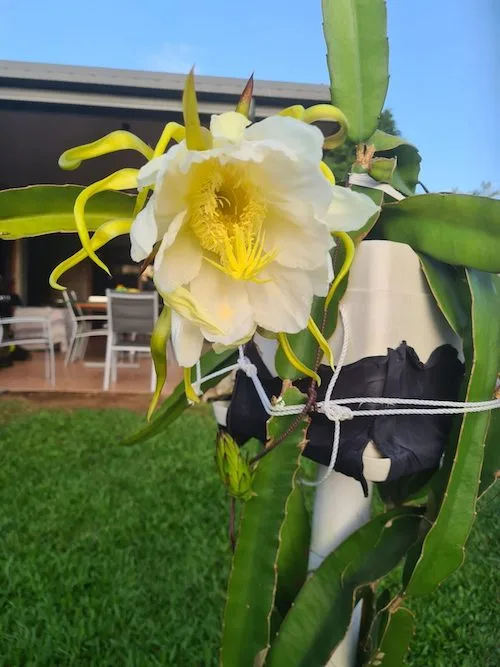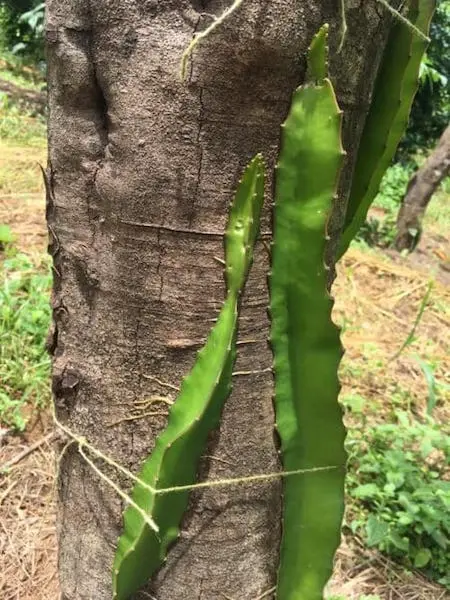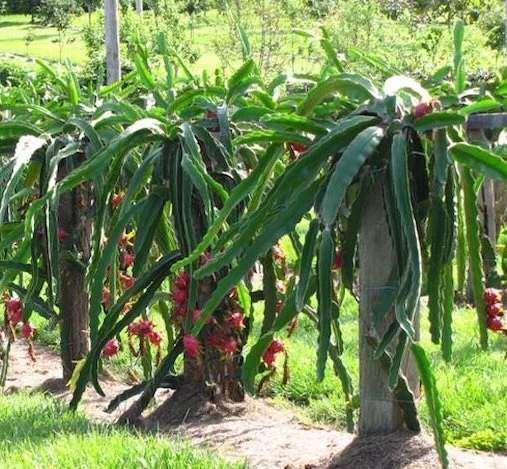Table of contents
- Dragon Fruit Growing in Australia
- Dragon Fruit Growing Conditions
- Dragon Fruit Growing from Seed
- Dragon Fruit Growing Stages
- Dragon Fruit Cuttings
- Dragon Fruit Growing in Pots
- How Long Does Dragon Fruit Take to Grow
- Dragon Fruit Growing Season
- How to Support Dragon Fruit Plants
- Dragon Fruit
- Dragon Fruit Plant Bunnings
Dragon Fruit Growing in Australia
This dragon fruit growing guide is for lovers of this tropical climbing cactus, which produces a fruit with scales reminiscent of a dragon.
Originally from South Mexico and Central America, dragon fruit (Hylocereus), also known as pitaya or strawberry pear, is now grown around the world. A member of the cactus family, this unique climbing cactus produces an oval shaped fruit with pointy scales.
This plant is sometimes referred to as the moonlight cactus on account of its flowers that bloom only at night. It produces footlong fragrant flowers in addition to a nutritious tropical fruit.
Dragon Fruit Flower

Dragon Fruit Growing Conditions
Growing well in tropical gardens, the perennial dragon fruit also grows well in the sub-tropics.
Location and Soil
Dragon fruit requires at least six hours of sunlight per day, but are best planted in full sunlight. It is a climber, so it must be supported with a stake, trellis or some other structure it can climb on.
When growing, go for well-draining soil that is sandy and loamy. A mixture of sand in garden soil is best. That said, the plant is forgiving to poor soil, as long as it is not too swampy.
Fertilising Dragon Fruit
Like the paw paw, dragon fruit is fairly low maintenance. They do not need heavy fertilising. In fact, over fertilisation will harm your plant. Choose an organic, balanced fertiliser and apply every six weeks during its peak growing season. There is no need to fertilise during the winter months, especially if you are living in a cool climate.
Watering
It is possible to kill a plant by over-watering it. In a tropical wet-season, dragon fruit can handle torrential downpours, but there is no need for additional watering. If you water the plant too often, this can cause root rot.

Dragon Fruit Plant
The dragon fruit is a very robust plant. Common pests include caterpillars, snails and slugs, but they can be easily treated. Caterpillars can be easily picked off when you see them. Snails and slugs can chew away large sections and interfere with the initial training of the main stems.
Pruning
Pruning is an important part of dragon fruit growing. Otherwise your plant will easily get out of control. Pruning is needed to shape the plant on the trellis. Regular pruning improves air circulation, and prevents fungal infection.
Over time your cactus can grow quite large, so a popular method is to plant against a thick stake or post and tie one or two main stems to it, in order to support it and encourage vertical straight growth.
One then trims away any side shoots and after the stems have reached the desired height, you cut off their ends to encourage new branching shoots. The newb branches that shoot out will then spread and hang downwards. This will provide fruit at a pickable height.
Dragon Fruit Growing from Seed
Propagating dragon fruit from seed is easy. Dragon fruit is self-reproducing, so you only need one plant to grow from. You can propagate this plant with seeds from the fruit itself. Simply wash the seeds and dry them overnight before planting them in a seed-starting tray with moist soil. The seeds should germinate within two weeks.
Dragon Fruit Growing Stages
Dragon fruit, also known as pitaya or pitahaya, goes through several stages of growth before it is ready to harvest. Here are the typical stages:
Germination: This is the initial stage where the dragon fruit seed begins to sprout and grow roots.
Seedling: Once the seed has sprouted, it grows into a young plant with a few small leaves. This stage requires careful nurturing to ensure the seedling develops a strong root system.
Vine Formation: Dragon fruit plants are climbers, and they develop long, thin stems or vines that grow upwards. These vines need support as they continue to grow.
Flowering: Dragon fruit plants usually begin to flower when they are mature enough, typically after about a year or so of growth. The flowers are large and ornate, usually white or yellow, and they often bloom overnight.
Fruit Development: After successful pollination (often done by bats or insects), the flowers develop into fruits. The fruits start out small and green, then gradually grow larger and begin to change color as they ripen.
Ripening: Dragon fruits ripen on the plant and are typically ready to harvest 30-50 days after flowering. They change color from green to pink or red (depending on the variety), and the skin becomes slightly yellow.
Harvesting: Once ripe, dragon fruits are carefully harvested by cutting them from the plant. They should be handled with care to avoid damaging the delicate skin.
Each of these stages requires specific care and attention to ensure healthy growth and a good harvest of dragon fruits.
Dragon Fruit Cuttings
Propagating a dragon fruit from a cutting is fairly simple. Trim off a 30cm (12in) section of a dragon fruit tree and leave it to dry out for 5-6 days or until the cut end has dried out. Then place cut side down into sandy cacti soil and water monthly.
Your plant will send out roots and make itself at home within a month and then continue to grow. However, you will need to wait from one to three years for your first fruit using this method.
Dragon Fruit Growing in Pots
If you are growing dragon fruit in a cool climate or you don’t have much space, you can grow dragon fruit in a pot. This allows you to move it during winter to protect it from frost, as it will not survive long periods of freezing temperatures and frost.
Start the plant in a smaller pot around 25cm (10 Inches) deep and re-pot when the plant seems root-bound. A large pot that is 50-60cm (20-24 Inches) deep is enough to accommodate a mature tree. However make sure the pot has drainage holes.
Fungal problems can occur where you have high humidity and overhead watering. However, pruning of the plant and removing additional branches will improve airflow. Other treatments for fungal infections are application of a copper-based spray and reduced watering.
How Long Does Dragon Fruit Take to Grow
Dragon fruit, also known as pitaya, typically takes about 1 to 2 years to grow from seed to fruit-bearing maturity. However, the exact time can vary based on several factors such as the variety of dragon fruit, growing conditions (such as climate and soil).

Dragon Fruit Growing Season
Dragon fruit typically grows and fruits in warm, tropical and subtropical climates. Its primary growing and fruiting season spans summer to early fall, particularly from late spring through early autumn. In warmer climates, such as those found in parts of Australia, Southeast Asia, and Central and South America, dragon fruit plants can flower and bear fruit several times within this period.
During this season, dragon fruit thrives best with:
- Warm temperatures (ideally between 20-30°C or 68-86°F)
- Plenty of sunlight
- Regular, moderate watering
In regions with cooler winters, dragon fruit will often enter a semi-dormant state until the warmth returns in spring. For those growing dragon fruit outside its native tropical climate, maintaining warm temperatures and proper sunlight exposure is key to ensuring a fruitful season.
How to Support Dragon Fruit Plants
Supporting dragon fruit plants is essential as they are climbing cacti that require a sturdy structure to grow vertically, which also helps improve air circulation, sunlight exposure, and ease of harvest. Here’s how to support dragon fruit plants effectively:
- Choose a Strong Support Post or Trellis
Use sturdy materials, such as treated wood, metal, or concrete posts, that can support the plant’s weight as it grows and bears fruit. Posts should ideally be 6-7 feet tall with a top crossbar to allow the plant to spread out.
A circular or square trellis at the top of the post is also popular, as it allows the branches to cascade over, which can increase flowering and fruit production. - Use Ties to Train the Plant
As the plant grows, loosely tie the main stems to the post using soft ties like garden twine or fabric strips. Avoid tight ties to prevent damaging the plant.
Continue to train the stems upward, pruning any side branches until the plant reaches the top of the support. - Allow for Spreading at the Top
Once the main stem reaches the top of the post, let the branches grow and cascade downwards, which encourages flowering at the tips. The additional spread at the top also provides space for multiple flower and fruit clusters. - Regularly Check and Maintain the Support
As the plant grows, check for any ties that may need adjusting or posts that may need reinforcing to handle the increased weight.
Prune excess branches to manage the plant’s size and to ensure the structure can continue to support it without being overburdened. - Consider Weather Conditions
In areas with strong winds, ensure that the support is firmly anchored in the ground, and consider using heavier posts or concrete bases to keep the support stable. Providing this vertical support for your dragon fruit plant helps encourage healthy growth and productive fruiting by allowing the plant to maximise its exposure to sunlight and air.
Dragon Fruit
We could not give you dragon fruit growing tips without giving you some eating tips!
The fruit weighs about 150–600g (5-20oz), with pink, crimson, yellow or red coloured skin and fleshy green scales on the exterior. Further, on the inside, the fruit has translucent white or red flesh with tiny black seeds, and the flesh is sweet to mildly sweet, with a light melon-like taste.
There are a number of ways to consume the fruit. First select a ripe fruit with bright red, evenly coloured skin that gives slightly when squeezed. Use a sharp knife and cut straight through the fruit, slicing it in half.
Use a spoon to scoop the fruit out of the skin or peel the skin off and slice the pulp into small pieces. Other ideas for serving the fruit are:
- Simply slice it up and eat as is.
- Chop it into small pieces and top with Greek yogurt and chopped nuts.
- Include it in a salad.
- Drink it in smoothies

Dragon Fruit Benefits
The fruit is extremely healthy and some even describe it as a ‘super food’. Indeed it is full of antioxidants, easy to digest carbohydrates, and omega fatty acids in the seeds.
Weight Loss
Dragon fruit is low in sugar (compared to other fruits) and has fewer carbs than most.
Fibre
With 7 grams per one-cup serving, this fruit is an excellent source of fibre. As a result, eating dragon fruit can help to bulk up bowel movements and relieve constipation.
Immune System
The vitamin C in the fruit can boost your immune system. In addition, it is a great source of magnesium, a nutrient needed for over 600 biochemical reactions in your body.
Antioxidants
The fruit contains several antioxidants that protect your cells from damage. Indeed these include betalains, hydroxycinnamates, and flavonoids.
Prebiotics
Eating dragon fruit is healthy, as the fruit contains prebiotic fibre that enhances digestion and nourishes gut bacteria. Further, this prebiotic property can help reduce the risk of diarrhoea and promote gut health.
Dragon Fruit Plant Bunnings
These trees can sometimes be purchased from Bunnings. However, why not consider supporting a local nursery? They often have what you need and a lot more besides. Also, often local nurseries sell products suited to the local climate.
We hope this article helps and wish you good results with your dragon fruit growing.


Comments
3 responses to “Dragon Fruit Growing Guide”
[…] Dragon Fruit […]
[…] the tropics, this plant grows all year round. Like dragon fruit, the paw paw is very easy to grow. Flowering takes place over many weeks, so fruit can exist […]
[…] Dragon Fruit […]